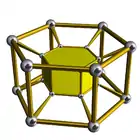4-6 duoprism
In geometry of 4 dimensions, a 4-6 duoprism, a duoprism and 4-polytope resulting from the Cartesian product of a square and a hexagon.
Uniform 4-6 duoprisms  Schlegel diagrams | |
|---|---|
| Type | Prismatic uniform polychoron |
| Schläfli symbol | {4}×{6} |
| Coxeter diagrams | |
| Cells | 4 hexagonal prisms, 6 square prisms |
| Faces | 24+6 squares, 4 hexagons |
| Edges | 48 |
| Vertices | 24 |
| Vertex figure | Digonal disphenoid |
| Symmetry | [4,2,6], order 48 |
| Dual | 4-6 duopyramid |
| Properties | convex, vertex-uniform |
The 4-6 duoprism cells exist in some of the uniform 5-polytopes in the B5 family.
Images
 Net |
4-6 duopyramid
| 4-6 duopyramid | |
|---|---|
| Type | duopyramid |
| Schläfli symbol | {4}+{6} |
| Coxeter diagrams | |
| Cells | 24 digonal disphenoids |
| Faces | 48 isosceles triangles |
| Edges | 34 (24+4+6) |
| Vertices | 10 (4+6) |
| Symmetry | [4,2,6], order 48 |
| Dual | 4-6 duoprism |
| Properties | convex, facet-transitive |
The dual of a 4-6 duoprism is called a 4-6 duopyramid. It has 18 digonal disphenoid cells, 34 isosceles triangular faces, 34 edges, and 10 vertices.

Orthogonal projection
Related polytopes
The 2-3 duoantiprism is an alternation of the 4-6 duoprism, represented by ![]()
![]()
![]()
![]()
![]()
![]()
![]()

Vertex figure for the 2-3 duoantiprism
See also
Notes
References
- Regular Polytopes, H. S. M. Coxeter, Dover Publications, Inc., 1973, New York, p. 124.
- Coxeter, The Beauty of Geometry: Twelve Essays, Dover Publications, 1999, ISBN 0-486-40919-8 (Chapter 5: Regular Skew Polyhedra in three and four dimensions and their topological analogues)
- Coxeter, H. S. M. Regular Skew Polyhedra in Three and Four Dimensions. Proc. London Math. Soc. 43, 33–62, 1937.
- John H. Conway, Heidi Burgiel, Chaim Goodman-Strass, The Symmetries of Things 2008, ISBN 978-1-56881-220-5 (Chapter 26)
- Norman Johnson Uniform Polytopes, Manuscript (1991)
- N. W. Johnson: The Theory of Uniform Polytopes and Honeycombs, Ph.D. Dissertation, University of Toronto, 1966
- Catalogue of Convex Polychora, section 6, George Olshevsky.
External links
- The Fourth Dimension Simply Explained—describes duoprisms as "double prisms" and duocylinders as "double cylinders"
- Polygloss – glossary of higher-dimensional terms
- Exploring Hyperspace with the Geometric Product